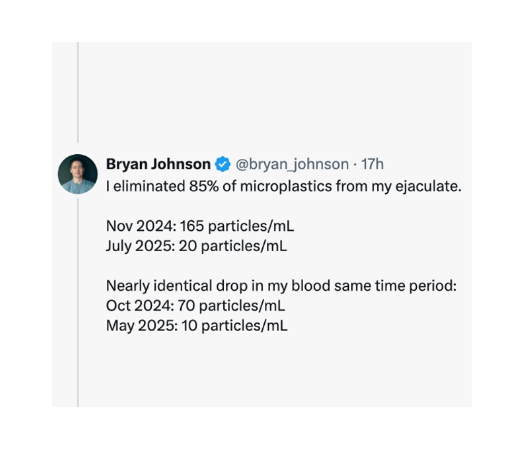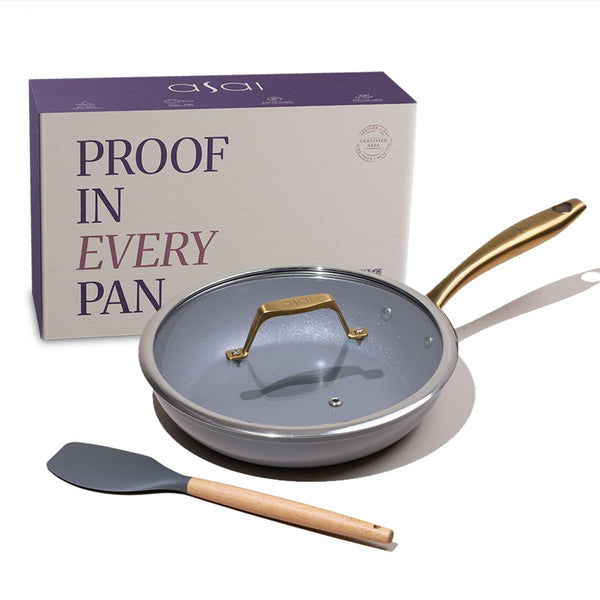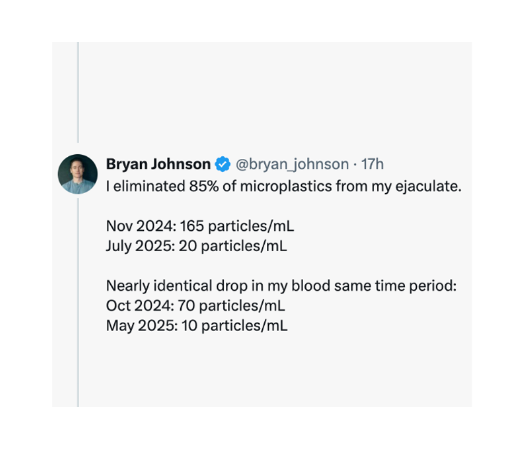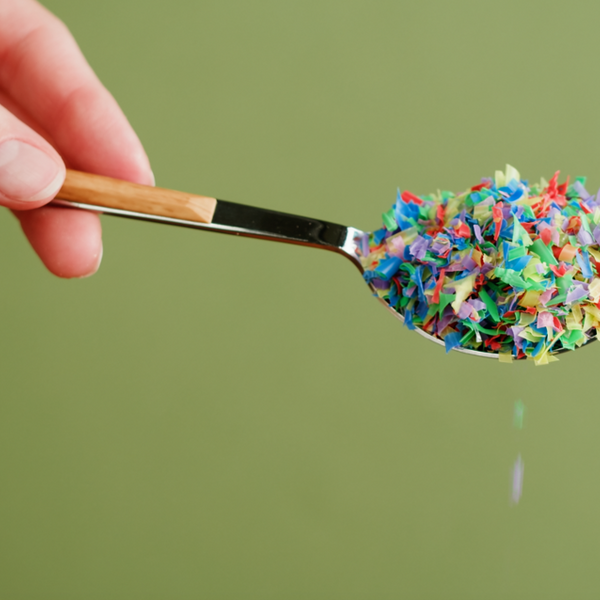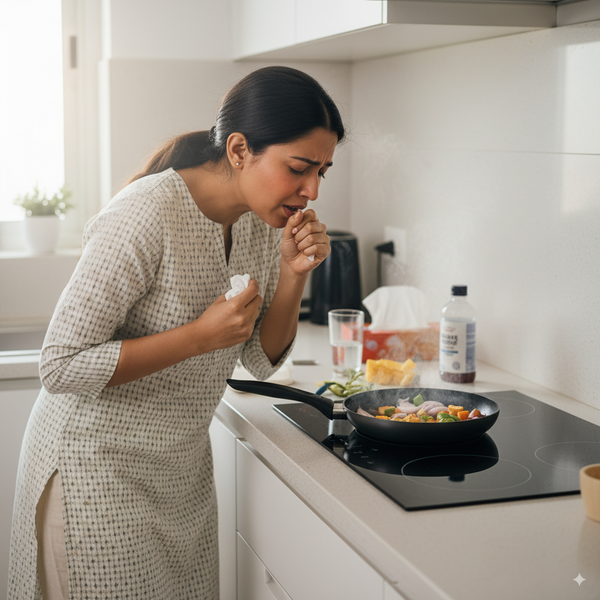Did Bryan Johnson Really Eliminate 85% of Microplastics From His Blood? The Kitchen Secret Big Brands Don’t Want You to Know
What’s Behind Bryan Johnson’s 85% Microplastic Drop?
Let’s not sugarcoat it: you probably have microplastics inside you right now. I know, I wish that was an exaggeration. But billionaire-biohacker Bryan Johnson—the guy who literally makes optimizing his body a full-time job—found out his blood and, uh, other fluids had microplastics floating around too[1]. The wild part? After making a lot of lifestyle changes (including ditching his nonstick pans), his test showed microplastics went from 15 to just 1 particle. That’s around an 85% drop. The therapy he thinks is most responsible for this reduction is sauna as it also eliminated most environmental toxins in my body, including those linked to various plastics (200 F, 20 min daily w/ ice on the boys). He also avoided the big no-no’s like microwaving in plastic, plastic cutting board, non-stick pans, and having a reverse osmosis water system.

So… what’s going on in our kitchens? Are our supposedly “safe” pans dropping invisible plastic bits into our food? Here’s why Johnson’s results are setting the internet (and scientists) abuzz.
How Do Nonstick Pans Leak Microplastics Into Your Food (and Body)?
Ever noticed how “nonstick” pans get a little less nonstick over time? That’s the PTFE (yep, Teflon) coating wearing down. Turns out, every scrape from a spatula and every high-heat sizzle chips off tiny particles—some big enough to see, many too small for the naked eye[1]. And these slivers? They don’t just disappear. They swirl around in your scrambled eggs. You eat them. Your body tries to deal. The result: microplastics building up where you really, really don’t want them.
Shocking Science: PTFE Particles Found in Human Blood and Organs
Here’s the stuff that makes you want to clean out your cupboards right now—a 2025 pilot study found PTFE particles not only in human blood, but clear inside kids’ tonsils[5]. Like, deep inside tissue. That means these plastics are crossing from your food, through your gut, and ending up places they should never be. And it’s not just one study. The more researchers look, the more they’re finding evidence that microplastics slip into cells and might even tweak how your genes work[5][6].
Why Johnson’s Kitchen Makeover Made Such a Big Difference
Look, Bryan Johnson isn’t your average health nut. The guy’s running “protocols” most of us can’t even pronounce. But his kitchen changes were surprisingly simple—and they seemed to pack the biggest punch. Tossing every PTFE-coated pan. Swapping plastic food containers for glass. Not microwaving leftovers in plastic[1]. He stacked that with things like daily saunas and some heavy-duty blood filtering. But if you take one thing from his results, it’s this: that sneaky PTFE coating in nonstick pans? It’s likely a big source of microplastics[1].
How You Can Cut Microplastics in Your Own Kitchen—Without Going Extreme
- Swap out nonstick pans for ceramic. Seriously, ceramic is where it’s at—no plastic coatings, no leaching at high heat.
- Chuck the plastic containers. Go for glass (or at least use glass for reheating meals).
- Filter your tap water. Reverse osmosis is the gold standard, but even a basic pitcher filter can help.
- Skip synthetic fabrics if you can. Less plastic in your home means less in your food (and, weirdly, your body)[1].
The Simple Cookware Swap: Why Ceramic Wins Over Cast Iron and Teflon
Alright, cookware. This is where folks get heated (pun intended). Cast iron’s classic. Teflon’s easy. But ceramic? Ceramic is the hero nobody talks about. Here’s why:
- No plastic at all—so nothing to chip, melt, or flake into your food.
- Super nonstick without needing weird coatings.
- Handles high heat like a champ.
So if you’re thinking about tossing your battered old pan, ceramic is absolutely the way to go. You’ll cook safer and honestly, cleanup’s a dream compared to worrying about a razor-thin nonstick layer. At Asai, we have a range of Ceramic Pans that are 100% Free from PFAS, microplastics & 70+ Hidden toxins. Explore our Ceramic Collection!
Are Microplastics in Nonstick Pans a Real Threat, or Just Another Health Hype?
Let’s cut through the noise. Yes, you’re probably getting microplastics from a bunch of places—water, food wrappers, maybe that old takeout container. But if you’re cooking at home a lot? Nonstick pans are a hidden, sneaky source nobody talks about. The science behind this isn’t hype: microplastics turn up in blood and organs in multiple studies, and Bryan Johnson’s blueprint makes it clear ditching PTFE products made a measurable difference[1][5]. Could more data come out? Of course. But the signal’s already there, and not just for biohackers.
What Experts and Biohackers Want You to Know About Staying Safe
Here’s what stuck with me after reading Johnson’s journey and the science:
We’re all “kind of flying blind” when it comes to microplastics.[4] Even the labs can barely test for them. So being proactive—in ways you can actually control—just makes sense. Scientists from Stanford and Chicago say the risks are real enough to start limiting exposure, even if we’re still learning the details[5][6]. And swapping out your cookware? Low effort, high reward move.
“We’re kind of flying blind, like all 8 billion of us on earth, when it comes to microplastics.”
— Bryan Johnson[4]
Wrap-Up: The Real Secret in Johnson’s Microplastic Drop
Here’s the thing—so many of us worry about the wrong plastics. Meanwhile, we stir soup, flip pancakes, and never think twice about what’s flaking off our pans. Bryan Johnson’s test wasn’t magic or billionaire trickery. He just figured out a quiet kitchen switch (ditching PTFE-coated pans) that actually cut a clear chunk of microplastics from his body. And the best news? You can do this, too, no lab or plasma exchange required.
So if you’re looking for a kitchen swap with real-life impact, focus on your nonstick—pick ceramic. Your body (and maybe your future doctor) will thank you.
FAQs
A: Yes, studies show PTFE-coated nonstick pans can shed tiny plastic particles into your food, especially as they age or are scratched, which can end up in your body over time.
A: According to Johnson’s own test results, ditching nonstick pans and plastic containers led to an 85% drop in the microplastics found in his blood—so even small kitchen swaps can matter.
A: Experts and biohackers recommend uncoated ceramic or glass cookware, since they don’t shed plastic particles—even at high heat—and are easy to switch to at home.
Sources:
- How Bryan Johnson Removed 93 Percent of Microplastics From His Blood – iwontdie.com
- Bryan Johnson YouTube Interview – youtube.com
- Blueprint Microplastics Test Overview – blueprint.bryanjohnson.com
- How to Test for Microplastics (Blog) – blueprint.bryanjohnson.com
- What’s the deal with microplastics? (Stanford, 2025) – news.stanford.edu
- How Microplastics Are Invading Our Bodies (UChicago) – news.uchicago.edu


